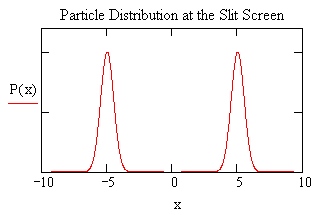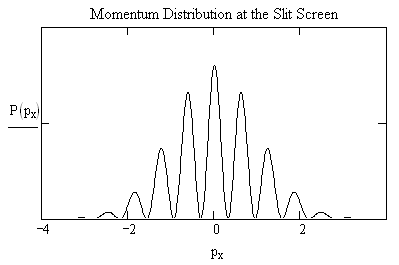5.18: Another Look at the Double-Slit Experiment
- Page ID
- 150543
Illumination of a double-slit screen with a coherent particle beam leads to a Schrödinger "cat state" that can be represented by a linear superposition (unnormalized) of two Gaussian wavepackets. The probability distribution function in coordinate space, |Y(x)|2, at the slit-screen for this "cat state" is shown below.
\[ \begin{matrix} x = -10, ~ -9.99 .. 10 & \Psi (x) = exp \left[ -(x-5)^2 \right] + exp \left[ - (x + 5)^2 \right] & P(x) = \left( \left| \Psi (x) \right| \right)^2 \end{matrix} \nonumber \]

The slits localize the particle in the x-direction which leads to a spread in the x-component of the momentum required by the uncertainty principle, DxDpx > h/4p. The momentum wave function is obtained by a Fourier transform of the coordinate-space wave function.
\[ \Phi (p_x) = \frac{1}{ \sqrt{2 \pi}} \left[ \int_{- \infty}^{ \infty} exp (-i p_x x) \left[ exp \left[ - (x-5)^2 \right] + exp \left[ - (x+5)^2 \right] \right] dx \right] \nonumber \]
Evaluation of the integral yields,
\[ \Phi (p_x ) = \frac{1}{ \sqrt{2}} \left[ exp \left[ \frac{-1}{4} p_x (p_x + 20i) \right] + exp \left[ \frac{-1}{4} p_x (p_x - 20i \right] \right] \nonumber \]
The momentum probability function in the x-direction is |F(px)|2 and simplifies to the expression given below when evaluated.
\[ P(p_x) = 2 exp \left( \frac{-1}{2} p_x^2 \right) \cos (5 p_x )^2 \nonumber \]
This momentum probability function is displayed below.
\[ p_x = -4, -3.99 .. 4 \nonumber \]

Because the arrival at position x on the detection screen is proportional to px it is also proportional to |F(px)|2. In other words, the particle distribution at the detection screen is determined by the momentum distribution at the slit screen. This means the position measurement at the detection screen is effectively a measurement of the px. Therefore, the particle distribution at the detector screen will have the same shape as shown in the figure above.
In summary, the double-slit experiment clearly reveals the three essential steps in a quantum mechanical experiment:
1. State preparation (interaction of the incident beam with the slit-screen)
2. Measurement of an observable (arrival of scattered beam at the detection screen)
3. Calculation of expected results of the measurement step
*The preparation of this tutorial was stimulated by reading "Quantum interference with slits" by Thomas Marcella which appeared in European Journal of Physics 23, 615-621 (2002). This paper offers a lucid and novel quantum mechanical analysis of a very important experiment.
Additional references:
R. P. Feynman, R. B. Leighton, and M.Sands, The Feynman Lectures on Physics, Volume 3; Addison-Wesley; Reading, 1965, Chapters 1 and 3.
R. P. Feynman, The Character of Physical Law; MIT Press: Cambridge, 1967, Chapter 6.
A. Tonomura, J. Endo, T. Matsuda, T. Kawasaki, and H. Exawa, "Demonstration of single-electron buildup of an interference pattern" Am. J. Phys. 57, 117-120 (1989).
D. Leibfried, T. Pfau, and C. Monroe, "Shadows and Mirrors: Reconstructing Quantum States of Atom Motion" Phys. Today 51(4), 22-28 (1998).
The double-slit experiment with single electrons was recently selected (informally) as physics most beautiful experiment. The following web reference traces the history of double-slit interference experiments from the time of Thomas Young to the present, presenting numerous literature references in the process: http://physicsweb.org/article/world/15/9/1.

